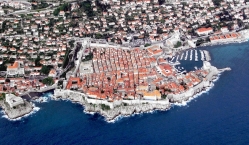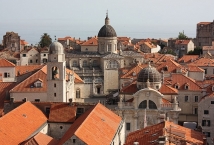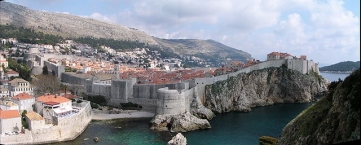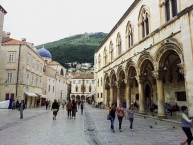Dubrovnik
Worth visiting
Added on 11 Sep 2014,
last edited by biroto-Redaktion on 16 Jan 2017
Nearby cycle routes and tours
| Route name | Type | Dist. to route |
|---|---|---|
Route | 0,2 km | |
Route | 0,3 km | |
Route | 4,9 km | |
Tour | 0,1 km | |
Tour | 0,5 km |
![]()
Please wait - map data are loading
Type of sights
Old town / World heritage site
Name and address
Dubrovnik
HR-20000 Dubrovnik
GEO-data
Geodetic coordinates
42.64∎∎∎∎ 18.10∎∎∎∎
Elevation
10 m
Communication
Information about copyright | |
|---|---|
Rights owner | |
Rights characteristic / license | by-sa: CREATIVE COMMONS Attribution-ShareAlike |
Link to the description of the license | |
Image taken over from | |
Image has been uploaded | by biroto-Redaktion on 11 Sep 2014
|
Information about copyright | |
|---|---|
Rights owner | |
Rights characteristic / license | by-sa: CREATIVE COMMONS Attribution-ShareAlike |
Link to the description of the license | |
Image taken over from | commons.wikimedia.org/wiki/File:Dubrovnik_-_Flickr_-_jns001_(63).jpg |
Image has been uploaded | by biroto-Redaktion on 11 Sep 2014
|
Information about copyright | |
|---|---|
Rights owner | |
Rights characteristic / license | by-sa: CREATIVE COMMONS Attribution-ShareAlike |
Link to the description of the license | |
Image taken over from | |
Image has been uploaded | by biroto-Redaktion on 11 Sep 2014
|
Information about copyright | |
|---|---|
Rights owner | |
Rights characteristic / license | by-sa: CREATIVE COMMONS Attribution-ShareAlike |
Link to the description of the license | |
Image taken over from | |
Image has been uploaded | by biroto-Redaktion on 11 Sep 2014
|
Dubrovnik (pronounced [dǔbroːʋniːk] ( Italian: Ragusa) is an old city on the Adriatic Sea coast in the extreme south of Croatia. It is one of the most prominent tourist resorts of the Mediterranean, a seaport and the centre of the Dubrovnik-Neretva County. Its population is about 43,000 in 2011. Dubrovnik is nicknamed "Pearl of the Adriatic" and is listed as a UNESCO World Heritage Site.
Understand
The city of Dubrovnik (Latin: Ragusa) was built on maritime trade. In the Middle Ages it became the only city-state in the Adriatic to rival Venice. Supported by its wealth and skilled diplomacy, the city achieved a remarkable level of development during the 15th and 16th centuries. Furthermore, Dubrovnik was one of the centres of the development of the Croatian language and literature, home to many notable poets, playwrights, painters, mathematicians, physicists and other scholars.
Dubrovnik used to be an independent republic, surviving mostly on trade. It managed to survive many centuries, with constant threats to its territory, particularly from the mighty Ottoman Empire and Venice. As early as the 19th century, it was discovered by celebrities as a place to be seen. George Bernard Shaw once said that "those who seek paradise on Earth should come to Dubrovnik and find it". Royalty, presidents and diplomats have all favored the city. The late Pope John Paul II was a fan of Dubrovnik and was even made an honorary citizen. Out of the 23 top luxury hotels in Croatia in 2010, 13 were located in Dubrovnik.
Dubrovnik is steeped in stunning architecture and sculptural detail, and boasts spectacular churches, monasteries, museums, and fountains.
See
Dubrovnik was heavily bombed in late 1991 during the Croatian War of Independence (part of a series of wars in the region). Almost all of the damage has been repaired; however, if you look closely around the old town, mortar damage in the cobblestone streets and bullet marks in the stone houses are visible.
Old Town
- Roland's Column (in front of the Bell Tower). A slender stone flag staff of the legendary knight. Also known as Orlando's Column. Ever since its foundation in 1950, the Dubrovnik Summer Festival is officially opened by raising a flag carrying the city's motto Libertus on Orlando's staff.
- Bell Tower (after the Ploče entrance to the city). On top of the tower are the famous 'Zelenci' (The Green Ones), bronze statues which strike the gigantic bell every hour. They have been recently replaced with copies and the originals are in the atrium of the Sponza Palace.
- ⊙ Sponza Palace (West of the Bell Tower). Gothic Renaissance palace, one of the few buildings that has maintained its form from before the catastrophic 1667 earthquake. Hosts historic archives. Memorial room of defenders. Open 10:00-22:00. 20 kn
- ⊙ Rector's Palace, Pred dvorom 1, ☎ +385 20 321437. Formerly the palace of the Major Council, now houses a museum dedicated to the city's history.
- War Photo Limited, Antuninska 6. Open 09:00-21:00. An exhibition centre of war and conflict photography. Exhibits change during the season. Stunning images by world renowned photo journalists.
- ⊙ Pile Gate, at the western end of the Placa Thoroughfare (Stradun) (Old town). A convenient starting place for your stroll through the Old Town is the Pile Gate. Before entering the Old Town, Fort Lovrjenac, the first among many sites worth seeing in Dubrovnik, provides a good view of the Old Town and its wall.
- Placa Stradun (Old town). The Stradun (Placa) is the central street of the city of Dubrovnik and is the place where the old city comes to life. During the day, explore the shades of the perpendicular streets and alleys on its sides, and during the night, take walks up and down the Stradun with an ice-cream in hand. The uniform Baroque architecture of the houses in Placa, with shops on the street level and their 'knee-like' entrances, got its present-day form in the restoration of the City taking place after the disastrous earthquake in 1667, when a large number of luxurious Gothic and Renaissance palaces had been destroyed. The architectural design of Placa reveals effective solutions and the business sense of the Dubrovnik Republic in those difficult times. Today, Placa is still the shopping centre and venue of major events.
- ⊙ Big Onofrio's Fountain. In the western (Pile) entrance of the old town, The fountain stairs are nowadays a favourite meeting place for local youth and where both the tourists and pigeons take rest and refresh themselves with cool water.
- Old Port. The eastern part of the Old Town of Dubrovnik; some cruise ship passengers are tendered to the Old Port.
- ⊙ Fort Lovrijenac. 9:00-17:30. The monumental fort rises above 37 m high rock. It changed roles in the course of history. The main purpose of its construction was defence, and the main idea was to protect the freedom of Dubrovnik. Not much remains in the way of historical artefacts but the fort gives spectacular views back upon the walled city. 30kn, or free by showing your City Walls ticket.
- Aquarium. 08:00-21:00. 30 kn.
- ⊙Visia Dubrovnik 5D Theatrum, Poljana Paska Miličevića 4 (in the Convent of St. Clare, on the right side at the beginning of Stradun through Pile gate), ☎ +385 20 324714. 09:00-20:00. Virtual reality technology guides visitors to Dubrovnik through the history and cultural features of the city and wider Croatia.
City walls
Walk on the walls around the old town, great views. It is highly recommended to visit the walls during the early morning hours or the late afternoon hours during mid-summer months as it can become hot.
Dubrovnik is surrounded by City Walls which are 2 km long and for which it is famous all around the world. Through the history City Walls were protection from the enemy, today Dubrovnik City Walls brings the visitors from the whole world who want to see this city- museum. There are 3 entrances to the City Walls: on Stradun by the Pile gate, by fort Saint John’s and at the Custom’s House gate.
Within the City Walls you will see Fort Minceta and Fort St. John’s on the south-eastern side. Also, within the City Walls are Fort Lawrence at Pile and Fort Revelin at Ploce. The main entrance to the City Walls is by the Inner Pile Gates.
⊙Minceta Fort is one of the most beautiful cultural attractions in Dubrovnik. It is situated on the northwest side of the city inside the City Walls. It was built according to the design of Renaissance builder Juraj Dalmatinac. St. Luke’s Tower you can see walking along the landward side of City Walls up to Ploce Gate. St. Luke’s Tower has protected the entrance to the Dubrovnik harbour throughout the history of the city.
St John’s Fort was constructed in 16th century and it is really worth of visiting- on its ground floor you can visit the Aquarium, and on first and second floor you can visit Maritime Museum. (more about it at the end of the page).
Bokar Fort is situated on the seaward of City Walls. It was designed by Florentine architect Michelozzi in the 15th century.
Hours: 08:00-19:00 summer, 10:00-15:00 winter, daily. Entrance fee to the walls: 120 kn for adults, 30 kn for children and 30 kn for students with a valid student card.
Churches
- ⊙ Franciscan Monastery, Placa 2, ☎ +385 20 321410. 09:00-18:00. This beautiful monastery with Baroque Church, houses a Romanesque cloister and the third oldest pharmacy in the world.
- ⊙ Cathedral of the Assumption of the Virgin Mary, Kneza Damjana Jude 1, ☎ +385 20 323459. M-Sa 08:00-20:00, Su 11:00-17:30. This impressive building is in the Poljana Marin Držić. Supposedly, the original church was built with money donated by Richard the Lionhearted who survived shipwreck on his way home from the Third Crusade. The current Roman Baroque cathedral dates from the 18th Century.
- ⊙ Church of Saint Blaise (Crkva Svetog Vlaha). Baroque Church dedicated to the city's patron saint.
- Church of St. Ignatius and the Jesuit College (On an elevated square close to the southern edge of the Old Town). Mass held in English daily at 11:00 in the summer. Ornate Jesuit church, approached via a romantic baroque staircase modelled on the Spanish Steps in Rome (1738). Built between 1667 and 1725 by architect Ignazzio Pozzo, and like most Jesuit churches of the period was modelled on the Gesù in Rome, the mother church of the Jesuits.
- ⊙ Dominican Monastery. Open 09:00-18:00. This is an exceptionally valuable historic complex, which, besides its religious purpose, also represents the important artistic treasury of ancient Dubrovnik.
- Church of St. Sebastian (by the Ploče gate). 15th-century church built by the Ploče gate since St. Sebastian is the saint protector against plague.
- Serbian Orthodox Church and Museum of Icons [Pravoslavna crkva i Muzej ikona]. Built from 1865-1877, stands behind impressive wrought iron gates. Houses a number of icons, mainly Byzantine and Cretan. Museum next to church has extensive icon collection. Church admission: free; Museum admission 5-10 kn.
Museums
Some museums offer a discount ticket if you visit more than one museum. For example its 40 kn for the Rectors Palace, 45 kn for Rectors Palace and Ethnographic museum, and 50 kn for Rectors Palace, Ethnographic museum and Maritime museum. You can use these tickets on multiple days.
- Bukovac House (Kuća Bukovac), Bukovčeva 5, Cavtat, ☎ +385 20 478646. 09:00 - 13:00, 16:00-20:00, Sun 16:00-20:00. Closed Mon. Includes works by Vlaho Bukovac (1855-1922), one of the most famous modern Croatian painters. Part of the house is devoted to exhibitions of works by young artists.
- Dubrovnik Natural History Museum (Prirodoslovni muzej), Androvićeva 1, ☎ +385 20 324888. 09:00-16:00, closed Sa-Su. The collection of 100 year-old taxidermy specimens dates back to 1872 and may not appeal to everyone.
- ⊙ Franciscan Monastery Museum, Placa 2. 09:00-18:00. Houses artifacts from one of the world's oldest pharmacies. 30 kn.
- Sigurata Convent Museum, Od Sigurate 13, ☎ +385 20 321467. Upon request. Entry: 10 kn.
- Synagogue and Jewish Museum, Zudioska 5, ☎ +385 20 321028. 10:00-15:00. This originally Sephardic Synagogue is supposed to be the second-oldest still in use synagogue in Europe today. A permanent Jewish community here was founded at the end of the 15th century following the expulsions from Portugal and Spain. The Jewish Ghetto was established in 1546 on Jewish Street in the old town of Dubrovnik. The community flourished and included respected doctors, merchants and state representatives. Jews in Dubrovnik enjoyed relative freedom, but there were some restrictions on their activities at certain points in history. The synagogue is tiny and delightful, with heavy velvet drapes and a richly painted, midnight blue ceiling. The museum contains valuable menorahs and Torah scrolls, alongside information on the history of the Jewish community in Dubrovnik.
- ⊙ Dominican Monastery Museum, Sv. Domina 4, ☎ +385 20 321423. 09:00-18:00. Paintings and artifacts from Dubrovnik's past. Entry: 20 kn.
- The Sponza Palace Museum (Museum of the State Archives). Entry: 20 kn.
- The Rector`s Palace Museum, Pred dvorom 1, ☎ +385 20 321437. 09:00-18:00. Artifacts, paintings and furniture dating back from the time of the Dubrovnik Republic. Entry: 40 kn.
- The Treasury of Cathedral, Kneza Damjana Jude 1, ☎ +385 20 323459. 09:00-18:00. The Treasury has 138 reliquaries which are carried around the city during the Feast of St Blaise. Entry: 15 kn.
- ⊙ Maritime Museum, In St. John Fortress, ☎ +385 20 323904. 09:00-18:00. Considering how vital sailing and shipbuilding were to the growth of the Dubrovnik Republic, this is one of the city’s most important museums. Entry: 40 kn.
- Home of Marin Držić, Široka 7, ☎ +385 20 420490. M-Sa 09:00-13:00 and by appointment. Memorial house of Marin Držić, a famous 16th-century Croatian playwright from Dubrovnik.
- The Etnographic Museum (Rupe Granary), Od Rupa 3, ☎ +385 20 323013. 09:00-18:00. Built in 1590, this is a fascinating building in itself, and the exhibits showcase the economic, cultural and spiritual development of Dubrovnik. The folk costumes and textiles give the best flavour of the region where folk culture is still celebrated. Entry: 40 kn.
Other
- ⊙ Stradun. Take a walk and enjoy a drink at a cafe on the main thoroughfare of the old town.
- Mount Srđ, For a great view of the town. There is a fortress on top which contains a small museum describing its history. There are several ways up:
- Walk up the winding footpath to the fortress and large cross on the hilltop 400 m above Dubrovnik. Walking up from the old town takes about 90 min. The path is quite rocky so use suitable footwear.
- Take the new renovated cable car and you will get from Down station to Mountain Srđ in less than 4 min. Round trip ticket 120 kn.
- Go by car via Bosanka village. Follow Jadranska cesta (D8) towards Mlini and drive past Dubrovnik. Turn left to Bosanka village and follow the road up the hill. There is also the bus number 17 from Pile to Bosanka. Timetable: http://libertasdubrovnik.com/wp-content/uploads/gradski.pdf
- Visit the ⊙Fortress Lovrijenac. It was an essential fortification for defense of the city from both ground and sea attacks. In order to prevent mutiny by the commander of the fortress, the walls facing the city are only 60 cm thick compared to those exposed to enemy fire which were 12 m thick. Above the entrance to the fortress is an inscription that says "Non bene pro toto libertas venditur auro" which translates to "Freedom is not sold for all the gold in the world".
Useful
Inside the range of 4 km:
- ⊙ Tourist-Information Dubrovnik, Dubrovnik
- ⊙ Tourist-Information GRUŽ Dubrovnik, Dubrovnik
- ⊙ Ferry from Dubrovnik to Bari, Dubrovnik
Information about copyright | |
|---|---|
Rights characteristic / license | by-sa: CREATIVE COMMONS Attribution-ShareAlike |
Link to the description of the license | |
Input taken over from: |
|
taken over / edited on | 11 Sep 2014 - 16 Jan 2017
|
taken over / edited by |
|
Nearby cycle routes and tours
| Route name | Type | Dist. to route |
|---|---|---|
Route | 0,2 km | |
Route | 0,3 km | |
Route | 4,9 km | |
Tour | 0,1 km | |
Tour | 0,5 km |
Added on 11 Sep 2014,
last edited by biroto-Redaktion on 16 Jan 2017




